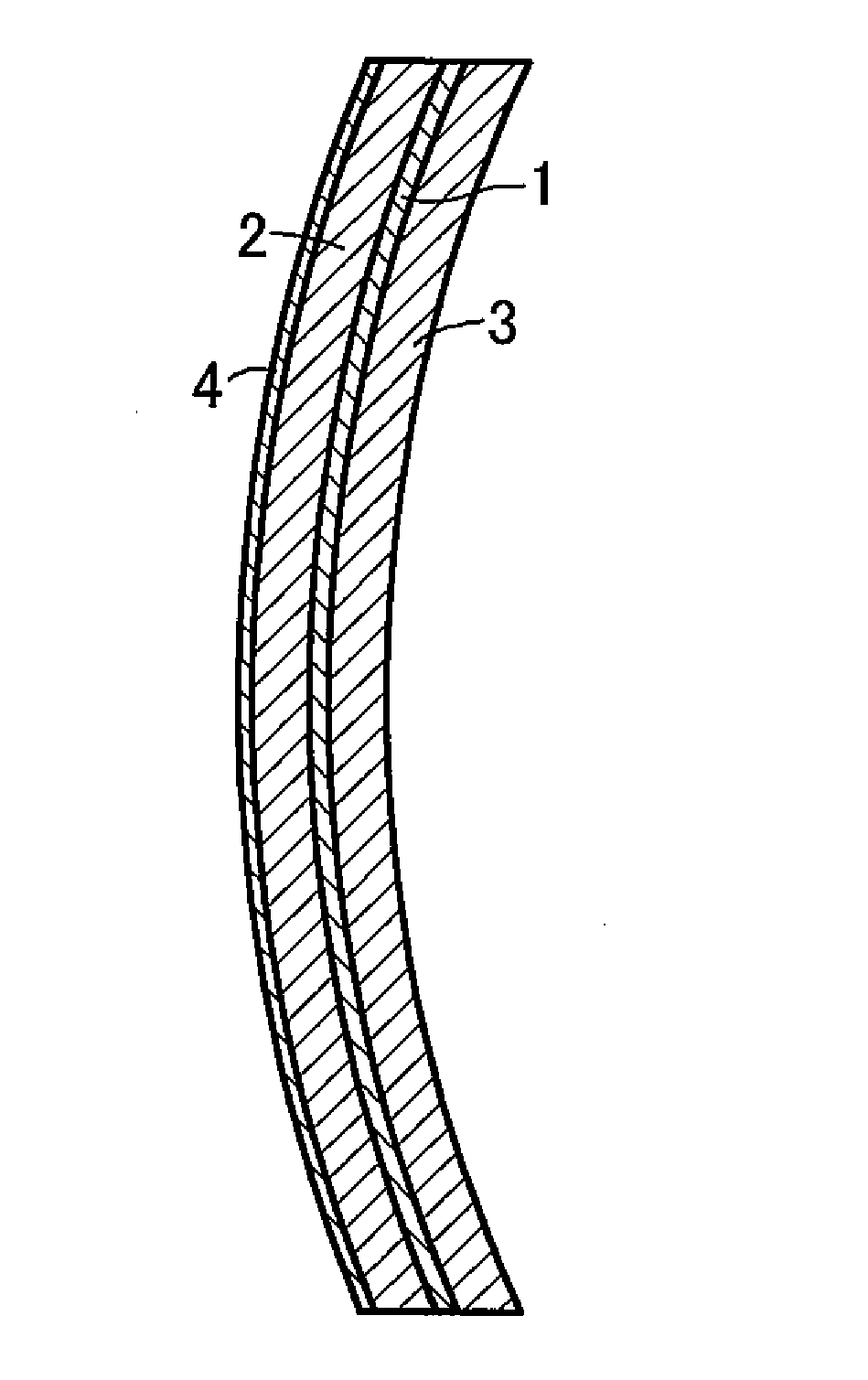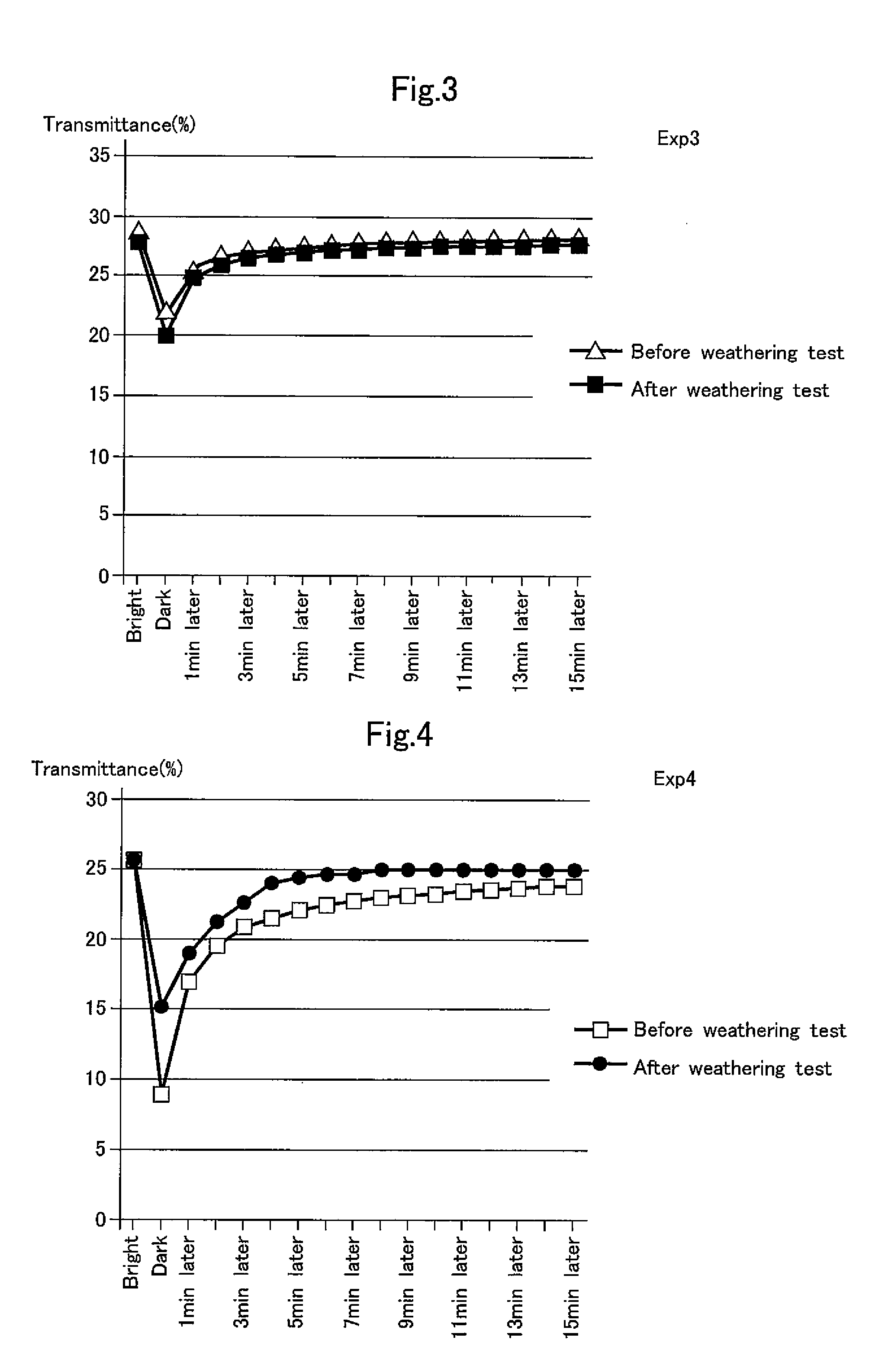Photochromic lens
- Summary
- Abstract
- Description
- Claims
- Application Information
AI Technical Summary
Benefits of technology
Problems solved by technology
Method used
Image
Examples
Example
Example 1
[0065]Based on 100 parts by mass of a prepolymer (not containing an ultraviolet absorbent) obtained by reacting a polyisocyanate with a polyhydroxy compound, 0.05 parts by mass of the spirooxazine photochromic compound (PSP-33, made by Yamada Chemical Co., Ltd.; reddish purple in color), 0.02 parts by mass of a bluish green spirooxazine photochromic compound (PSP-54, made by Yamada Chemical), and 0.06 parts by mass of an orange colored photochromic compound (PSP-92, made by Yamada Chemical) were dissolved in tetrahydrofuran (THF), and the THF was added to the prepolymer. The prepolymer and the THF were then mixed together, and the mixture was stirred and deaerated under vacuum. Aromatic polyamine (MOCA) was added to this prepolymer as a curing agent of an equivalent amount, and the prepolymer was formed into the lens by casting.
[0066]In particular, a photochromic lens for eyeglasses according to the present invention was obtained by injecting a liquid state resin material,...
Example
Comparative Example 1
[0068]A lens was formed by casting in exactly the same manner as in Example 1 except that acetone was used instead of tetrahydrofuran (THF), and the transmittance and the change in color tone with time were measured with a color difference meter under the same test conditions as in Example 1. The measurement results are shown in FIG. 1.
[0069]As is apparent from the test results of FIG. 1, because the solubility of the spirooxazine photochromic compound expressed by Chemical Formula 1 in acetone is low, the photochromic lens of Comparative Example 1 was significantly inferior in photochromic properties (difference between bright and dark). Longer time was needed until the lens regained its color before being exposed to ultraviolet radiation.
[0070]On the other hand, before being exposed to ultraviolet radiation, the photochromic lens of Example 1 was higher in transmittance by about 7% than the lens of Comparative Example 1, and thus was brighter than Comparative...
Example
Example 2
[0071]Two photochromic lens substrates were separately prepared by casting in which each of gray and brown plane polarizing films having a transmittance of 30% was set in a cavity of a glass mold defined by convex and concave surfaces and sealed by a gasket such that gaps of 2 mm were defined between the polarizing film and the convex surface and between the polarizing film and the concave surface, the same liquid-state resin material as used in Example 1 was injected into the cavity of the mold, and the resin material was gradually heated from the room temperature to 120° C., cured at 120° C. for four hours, cooled, removed from the mold, and annealed for two hours at 100° C.
[0072]A coating of an ultraviolet reflecting type antioxidant (NSC-5605D, made by Nippon Fine Chemical Co., Ltd.) was formed on the surface of the thus obtained lens substrate to obtain the photochromic lens of Example 2.
[0073]The thus obtained photochromic lenses were exposed to weather conditions cr...
PUM
 Login to View More
Login to View More Abstract
Description
Claims
Application Information
 Login to View More
Login to View More - R&D
- Intellectual Property
- Life Sciences
- Materials
- Tech Scout
- Unparalleled Data Quality
- Higher Quality Content
- 60% Fewer Hallucinations
Browse by: Latest US Patents, China's latest patents, Technical Efficacy Thesaurus, Application Domain, Technology Topic, Popular Technical Reports.
© 2025 PatSnap. All rights reserved.Legal|Privacy policy|Modern Slavery Act Transparency Statement|Sitemap|About US| Contact US: help@patsnap.com



